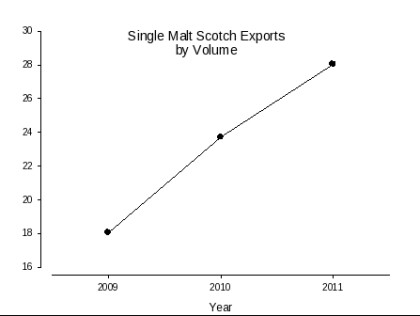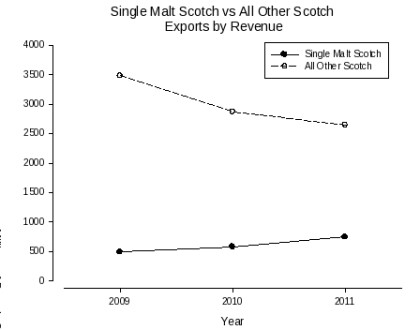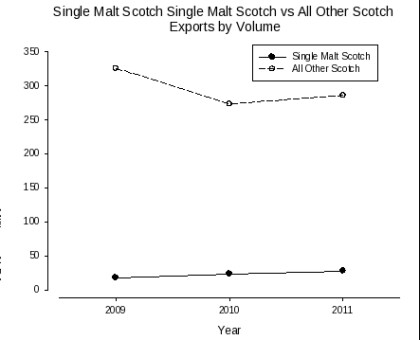Not Your Grandfather's Scotch, Ruby Marsannay [best novels to read for beginners .TXT] 📗

- Author: Ruby Marsannay
Book online «Not Your Grandfather's Scotch, Ruby Marsannay [best novels to read for beginners .TXT] 📗». Author Ruby Marsannay
Product
In a “marketing mix”, the product typically refers to the physical product, but in the spirits industry, the product (in this case, Single Malt Scotch Whisky) is almost synonymous with the brand. Furthermore, the brand not only encompasses the product, but also the lifestyle associated with that product., How and which lifestyle a brand chooses to sell is largely done through various promotion strategies, but it is also communicated to a certain extent through packaging. As such, a traditional label showcasing iconic Scottish imagery of kilts and bagpipes may not be enticing to female consumers, and it may send the wrong message that single malts are a “cold weather” drink to consumers living in warmer regions like Brazil. When planning for a single malt re-launch, the utilization of modern logos that are more gender- and geography-neutral should be considered. Highland Park successfully implemented this sort of label re-design strategy, whereby it replaced its “average packaging” with “stylish Celtic/Norse” imagery.
Price
Not only is Single Malt Scotch Whisky an expensive product to produce, it is also highly taxed, thereby greatly limiting the kinds of pricing options available compared to other spirits like premium vodka. In addition, there is always a fine line between making a product affordable enough for more consumers, and diminishing its level of exclusivity and prestige. Even geographical pricing might not be desirable if it is consequently perceived as a lower tier product.
So how to encourage consumers to try Single Malt Scotch Whisky, especially during troubled economic times? One option involves the introduction of a single malt half-bottle. This would make purchasing single malts more financially feasible to consumers in emerging economies like Brazil, or among female consumers who otherwise might not want to spend too much on something they will not drink in large amounts. If half-bottles of Single Malt Scotch Whisky were to be sold, the price per unit volume would be the same or possibly even a little higher, but consumers would pay less because they would be purchasing less. The sale of half bottles is rather common in the wine industry, and could prove to be successful for single malts.
Place
The place (or placement) portion of a marketing mix doesn’t exactly refer to where the product will be sold, but rather how it will get there. Since an established distillery would presumably have good distribution networks, the placement in established markets like the US would likely require little, if any, effort. On the other hand, it may be worthwhile considering how to expand distribution networks in new and emerging markets like Brazil. Forming joint ventures with other distributors and owners of complementary brands is one option. One such joint venture was that between LVMH and United Distillers (UDG), which helped strengthen UDG’s distribution networks in regions where they had been weak, such as in South East Asia. Another option is exploring the use of the Internet for online sales wherever possible.
Promotion
Living in a technological age has opened the floodgates to a brave new world of promotion strategies. If used correctly, the Internet and mobile phone applications could provide novel avenues for accessing more and increasingly specific target segments and at a cheaper price than ever before. Gone are the days of pricey airtime slots for prime time television shows; today, advertising on YouTube will reach more people and for a fraction of the price. Distillers could consider sponsoring online contests on social media sites such as Facebook, where potential customers can vote for their favorite contest entry (perhaps amateur films on responsible drinking). Heineken has sponsored several DJ contests, and this not only generates publicity for the beer, but young consumers also associate Heineken with festive occasions, such that they are more likely to consume that product at clubs and parties.
Mobile applications are another promising venue for promoting Single Malt Scotch Whisky. For instance, Spain’s Mahou beer released a mobile application in 2011 promoting the beer in Madrid. The “Mahou Mola” (“Mahou Rocks”) application provided weekly updates to the trendiest cafes, restaurants, bars, concerts, clothing stores, theatrical venues, etc. Not only did the application generate publicity for Mahou beer, but also served to associate Mahou beer drinkers as cosmopolitan trend-setters. A Single Malt Scotch Whisky re-launch promotion campaign could include mobile applications that convey the desired lifestyle image—be it fancy food and Scotch pairings, weekly cocktails recipes from famed Mixologists, whisky trivia games, etc. The use of mobile phone applications as an innovative promotion strategy, if done in a savvy and user-friendly manner, could be immensely popular in both the US and Brazil…or anywhere in the world, for that matter.
Conclusion
In summary, the SWOT analysis reveals that now is the best time for a Single Malt Scotch Whisky re-launch—costly regulations, high taxes, and general economic malaise notwithstanding. A strong brand name and good distribution networks are critical for a successful re-launch, and any weaknesses in these must be addressed in the Product and Place decision categories of the marketing mix. The sale of half-bottles could be a possible Pricing solution. Finally, modernity is key, not only in terms of packaging, but also in the use of various technological innovations for carrying out Promotion strategies. All of these factors, if properly applied, could lead to growth in markets like the US and Brazil…at least in the short term.
The quote provided at the beginning of this report—appropriately taken from the show Mad Men and pertaining to advertising—describes the utility of creating a sense of novelty and then exploiting the consumer’s reaction to it. However, that quote was immediately followed by a cautionary note about there being “a deeper bond with the product: nostalgia”. The same concept applies to single malts: a re-launch may attract new consumers and result in temporary growth, but those new consumers must be retained and that growth sustained in order for the Single Malt Scotch Whisky category to be truly successful.
Figure 1. Single Malt Scotch Exports in 2009, 2010, and 2011
by Revenue and Volume


Note: Graphs were generated using SigmaPlot software (version 11.0, Chicago, IL)
Data Sources: Scotch Whisky Association Statistical Report 2011, Scotch Whisky Association Statistical Report 2010
Figure 2. Comparison of Single Malt Scotch vs All Other Scotch Exports in 2009, 2010, and 2011
by Revenue and Volume


Note: Graphs were generated using SigmaPlot software (version 11.0, Chicago, IL)
Data Sources: Scotch Whisky Association Statistical Report 2011, Scotch Whisky Association Statistical Report 2010
Tables 1 & 2 are missing due to an upload error (contact author for data).
Table 3. SWOT Analysis for a Single Malt Scotch Re-Launch
Internal Factors
Strengths
Strong brand name (in current markets, eg. US)
Superior product
Unique taste profile (has “terroir”)
Already being made for blending
Already have necessary machinery for bottling and labeling
Established distribution networks (current markets eg. US)
Scotch is protected by the EU as a “geographical indication of origin”, and Scotch Whisky Regulations 2009 ensure Scotch stands apart from other spirits
Weaknesses
Weak brand name (in emerging markets like Brazil)
High cost to make product
Insufficient financial resources for marketing campaign
Too little or too much supply
Intra-brand competition (will it take away from blends?)
Late entry into market (missed the re-launch wave?)
Weak distribution networks (in emerging markets)
Use of resources that are not fully renewable (peat depletion and decreased replenishment rate)
External Factors
Opportunities
Currently popular and “cool” (eg, the “Mad Men Effect”)
Younger customers interested in premium product
More female customers drinking whiskey
Existing customers may like “new” face if done well
BRIC countries provide new markets increasingly interested in luxury products
Technological innovations (internet, mobile apps) open the door to newer and cheaper ways to reach target markets
Lowering of import taxes in some countries (eg, down to 10% in China)
Joint ventures may strengthen product range in emerging markets
Threats
Global recession (consumers may not be able to pay more for premium)
Legislation/regulations can increase costs (eg. effective 23 Nov 2012, single malt Scotch will only be exported in bottles ready for retail sale)
Restrictions on using new production methods (eg, SWA)
Excessive domestic and import taxes/surcharges (eg, 150% surcharge in India)
Popular now, but that could change
Risk of losing existing consumers through re-packaging (eg, New Coke)
Counterfeits and lawsuits could hurt reputation
Increasing competition, domestically and internationally
Bibliography
Daily Record. (2011, September 19). Retrieved 2012, from www.dailyrecord.co.uk/entertainment/tv-radio/mad-men-success-results-in-global-1082217.
Daily Record. (2012, January 25). Daily Record. Retrieved 2012, from www.dailyrecord.co.uk/news/scottish-news/scotlands-whisky-industry-under-serious-1114869.
Diageo. Retrieved 2012, from www.diageo.com/en-sc/ourbrands/categories/spirits/Pages/Whiskey.aspx.
Dow, A. (2011). Strategic Management of Channels of Distribution and Integrated Marketing Communications; Essay on the Scotch Whisky Industry. International Journal of Business and Social Science, Vol 2 No 22 , 108-113.
Fink, M. (2011, November 7). Today.com. Retrieved 2012, from http://today.msnbc.msn.com/id/45190809/ns/today-food/t/mad-men-effect-more-wome-get-taste-whiskey/#.UjafahwRW-M.
GlendDronach. Retrieved 2012, from http://glendronachdistillery.com/products.
Glenfiddich USA. Retrieved 2012, from www.glenfiddich.us/.
Heineken. Greensynergy. Retrieved 2012, from www.facebook.com/pages/Greensynergy/136466779728510.
House of Commons, Great Britain Parliament. (2010). Exporting out of recession: third report of session 2009-2010. Vol. II, Oral and Written Evidence. (p. 123). London: Stationery Office.
HRM Customs. www.hrmc.gov.uk/stats/trade-statistics.htm. Retrieved 2012
http://ec.europa.eu/trade/creating-opportunities/trade-topics/intellectual-property/geographical-indications/?message=ok. Retrieved 2012, from European Commission.
International Content Marketing Forum. (2011, May 13). ICMF. Retrieved 2012, from www.icpfonline.org/news/in-spain-colorful-actions-as-agencies-play-the-content-game.
Jones, S. (2002). Brand Building and Structural Change in the Scotch Whisky Industry. Dundee: University of Dundee.
LVMH. Retrieved 2012, from www.lvmh.com/the-grouop/lvmh-companies-and-brands/wines-spirits/the-glenmorangie-comany.
Mad Men, Season 1 Episode 13 (2006). [Television Show].
Malt Madness. Retrieved 2012, from www.maltmadness.com/whisky/glendullan.html.
Morrison Bowmore. Retrieved 2012, from www.morrisonbowmore.co.uk/partners/.
Morton, A. (2012, September 3). just-drinks. Retrieved 2012, from www.just-drinks.com/news/remy-cointreau-completes-bruichladdich-buy_id108036.aspx.
Pernod-Ricard. Retrieved 2012, from http://pernod-ricard.com/99/brands/see-all-brands.
Quick MBA. Marketing Mix. Retrieved 2012, from http://www.quickmba.com/marketing/mix/.
Quick MBA. SWOT Analysis. Retrieved 2012, from http://www.quickmba.com/strategy/swot/.
Scotch Whisky Association. (2011). Statistical Report .
Scotch Whisky Regulations. (2009).
The True Believer. (2008, July 31). Manducation. Retrieved 2012, from www.ploomy.com/2008/07/31/manducation-a-beginners-guide-to-single-malt-scotch-whiskey/.
University of St Andrews. (2012, January 25). Retrieved 2012, from www.st-andrews.ac.uk/news/archive/2012/Title,79615,en.html.
Wang, W. (2005). Marketing Expansive Strategies of Scotch Whisky in China Market: A Challenger's Perspective. Nottingham: University of Nottingham (MBA dissertation).
Wehring, O. (2012, October 18). just-drinks. Retrieved 2012, from www.just-drinks.com/news/ian-macleod-distillers-glengoyne-15-year-old-18-year-old-cask-strength_id108483.aspx.
William Grant & Sons. (n.d.). Retrieved 2012, from www.williamgrant.com/default.html.
Woodard, R. (2012, March 14). just-drinks. Retrieved 2012, from www.just-drinks.com/management-briefing/rebranding-in-the-drinks-industry-part-iii-rebranding-case-studies_id106560.aspx.
www.scotchhunter.com/distillery/single-malt-scotch-tasting. (n.d.). Retrieved 2012, from Scotch Hunter.
Zolfo-Cooper. (2011, November). "Viewpoint: On the Rocks?".
Page 9 of 21
Imprint
Publication Date: 07-26-2014
All Rights Reserved
Dedication:
To all of the single malt Scotch drinkers out there...





Comments (0)